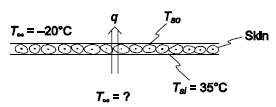In order to prevent frostbite to skiers on chair lifts, the weather report at most ski areas
Question:
In order to prevent frostbite to skiers on chair lifts, the weather report at most ski areas gives both an air temperature and the wind chill temperature. The air temperature is measured with a thermometer that is not affected by the wind. However, the rate of heat loss from the skier increases with wind velocity, and the wind-chill temperature is the temperature that would result in the same rate of heat loss in still air as occurs at the measured air temperature with the existing wind.Suppose that the inner temperature of a 3 mm thick layer of skin with a thermal conductivity of 0.35 W/(m K) is 35?C and the ambient air temperature is ??20?C. Under calm ambient conditions the heat transfer coefficient at the outer skin surface is about 20 W/(m2 K) (see Table 1.4), but in a 40 mph wind it increases to 75 W/(m2 K).(a) If frostbite can occur when the skin temperature drops to about 10?C, would you advise the skier to wear a face mask?(b) What is the skin temperature drop due to wind chill?GIVENSkier??s skin exposed to cold airSkin thickness (L) = 3 mm = 0.003 mInner surface temperature of skin (Tsi) = 35?CThermal conductivity of skin (k) = 0.35 W/(m K)Ambient air temperature (T??) = ??20?CConvective heat transfer coefficientsStill air (hc0) = 20 W/(m2 K)40 mph air (hc40) = 75 W/(m2 K)Frostbite occurs at an outer skin surface temperature (Tso) = 10?CASSUMPTIONSSteady state conditions prevailOne dimensional conduction occurs through theskin

Step by Step Answer:

Principles of heat transfer
ISBN: 978-0495667704
7th Edition
Authors: Frank Kreith, Raj M. Manglik, Mark S. Bohn





